Notes
Women to the Back of the Bus: A Picture of Gender Apartheid from Israel to Borough Park's B110
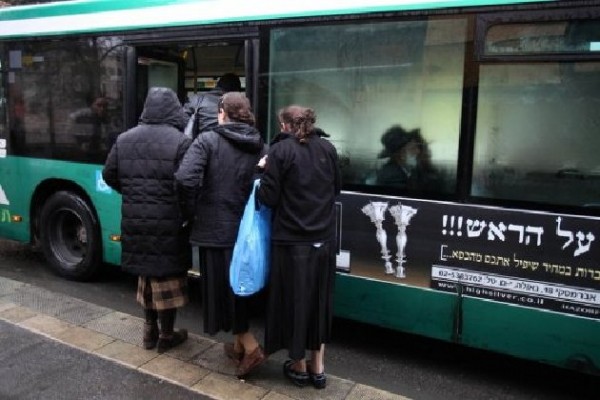 Israeli ultra-Orthodox Jewish women line up to board a bus from the back door in Jerusalem: A man from the town of Beit Shemesh was arrested on Monday over an assault on Sunday on a TV crew filming a sign instructing women to cross the street to avoid walking past a synagogue. © Gali Tibbon – AFP
Israeli ultra-Orthodox Jewish women line up to board a bus from the back door in Jerusalem: A man from the town of Beit Shemesh was arrested on Monday over an assault on Sunday on a TV crew filming a sign instructing women to cross the street to avoid walking past a synagogue. © Gali Tibbon – AFP
Though there is, unfortunately, plenty of gendered oppression to go around in the world, the Middle East has had its share of prominent skirmishes in the global war on women this past month (see the Bag’s coverage here and here). Add to that the recent controversy over gender segregation in some ultra-Orthodox Israeli neighborhoods which has produced more vivid images of 21st century gender apartheid.Women in certain parts of Israel have been (either voluntarily or under pressure) boarding the backs of public buses for years. In fact, the trend, which is only about a decade old, was increasing in popularity until events came to head last week. The Associated Press recounted the story of 28-year-old Tanya Rosenblit, who:
boarded a bus to an Orthodox neighborhood in Jerusalem. Shortly after she sat down behind the driver, a man wearing the black garb and flowing sidelocks of the ultra-Orthodox boarded the bus and asked her to move. She refused, and the man then blocked the bus from driving, she told The Associated Press.
She held her ground — even after a male police officer dispatched to the scene asked her if she was “willing to respect them and move to the back,” she said.
“I said, ‘I respected them enough with my modest dress and I don’t plan to humiliate myself to respect them or anyone else,’” she said.
CNN and other media outlets have begun calling Rosenblit “Israel’s Rosa Parks,” however, like Parks, she’s not alone in this struggle. According to the Jewish Chronicle, several years ago a grandmother identified only as “H” was harassed after refusing to move to the back of a gender-segregated bus. Her case and others eventually made their way to the Israeli Supreme Court, which ruled against segregating public buses and sidewalks. Yet the practice persists.
Gender segregation has spilled onto the sidewalks and into the schools of some ultra-Orthodox neighborhoods as well. In Beit Shemesh, Israel, 8-year old Naama Margolese was reportedly spat on and called a “whore” because her long sleeves and skirt were not “modest” enough for some of that town’s Orthodox citizens.
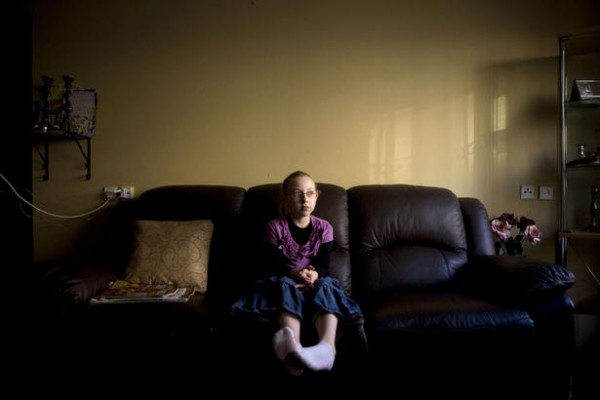 The story of Naama Margolese, an 8-year-old American girl that has unwittingly found herself on the front line of Israel’s latest religious war, drew new attention to the religious tensions in Beit Shemesh, a city of some 100,000 just outside Jerusalem, which has become a symbol of the growing violence of Jewish extremists in Israel in recent years. Oded Balilty/AP
The story of Naama Margolese, an 8-year-old American girl that has unwittingly found herself on the front line of Israel’s latest religious war, drew new attention to the religious tensions in Beit Shemesh, a city of some 100,000 just outside Jerusalem, which has become a symbol of the growing violence of Jewish extremists in Israel in recent years. Oded Balilty/AP
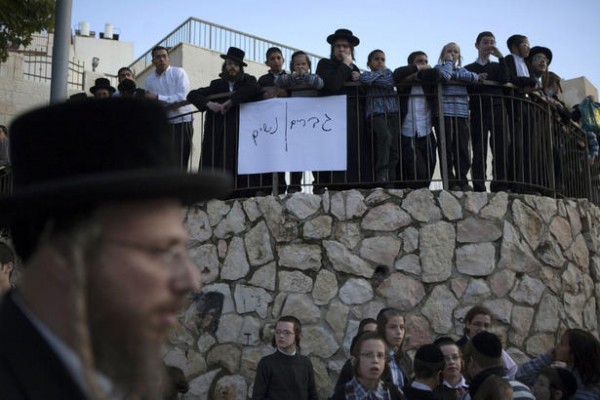 Ultra-Orthodox Jews stand next to a placard bearing a line separating the Hebrew words “Men, Women” during a protest in the central town of Beit Shemesh, near Jerusalem. Menahem Kahana/AFP/Getty Images.
Ultra-Orthodox Jews stand next to a placard bearing a line separating the Hebrew words “Men, Women” during a protest in the central town of Beit Shemesh, near Jerusalem. Menahem Kahana/AFP/Getty Images.
Images emerging from Israel currently bear more than a little resemblance to pictures taken in Montgomery, Alabama 50+ years ago. There’s no telling what may be going through the minds of the men in each of these pictures, but it’s fair to assume that even when the Supreme Court’s decision is honored, not all bus patrons are happy about integration.
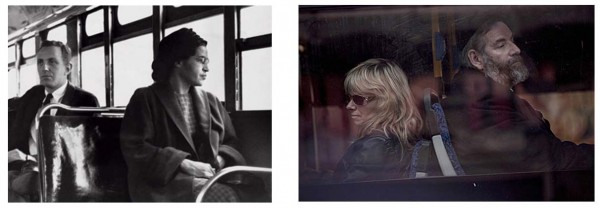 (L) Rosa Parks on a Montgomery bus on December 21, 1956, the day Montgomery’s public transportation system was legally integrated. UPI. (R) An Orthodox Jewish man sits close to a woman on a bus in the centre of Jerusalem earlier this month. Israel’s Supreme Court has ruled that public buses, which serve Israel’s most conservative, ultra-Orthodox communities, cannot enforce separation between the sexes. Menahem Kahana / AFP/Getty Images
(L) Rosa Parks on a Montgomery bus on December 21, 1956, the day Montgomery’s public transportation system was legally integrated. UPI. (R) An Orthodox Jewish man sits close to a woman on a bus in the centre of Jerusalem earlier this month. Israel’s Supreme Court has ruled that public buses, which serve Israel’s most conservative, ultra-Orthodox communities, cannot enforce separation between the sexes. Menahem Kahana / AFP/Getty Images
Still, as was argued during the U.S. Civil Rights movement, attitudinal change often follows legal mandate. Thus, the rationale behind Israel’s gender desegregation warrants consideration. Readers might assume that the secular majority in Israel rejects gender segregation because leaders and citizens oppose gender discrimination. During a cabinet meeting, President Netanyahu said, “Today I heard about moving a woman on a bus. I adamantly oppose that.” But wait, there’s more. According to the Associated Press, he followed that statement up by saying, “Fringe groups must not be allowed to tear apart our common denominator.” In fact, the recent furor over bus segregation may have more to do with political coalitions than it does feminist outrage.
Another Associated Press report explains that:
The ultra-Orthodox are perennial king-makers in Israeli coalition politics — two such parties serve as key members of the ruling coalition. They receive generous government subsidies, and police have traditionally been reluctant to enter their communities.
The ultra-Orthodox Jews make up 10 percent of Israel’s population and are its fastest growing sector because of a high birth rate. In the past, they have generally confined their strict lifestyle to their own neighborhoods. But they have become increasingly aggressive in trying to impose their ways on others, as their population has grown and spread to new areas.
So, gender segregation ultimately threatens citizens of either gender who belong to Israel’s secular majority. The (female) leader of the opposition in the Israeli parliament echoed Netanyahu’s rationale for opposing gender segregation, emphasizing political power over gender justice. According to the Associated Press, “Tzipi Livni said the struggle was not only for the right of women to sit at the front of buses, ‘but [for] the very face of Israel. There is a group in Israel that is trying to impose its lifestyle on the Zionist majority,’ she said.”
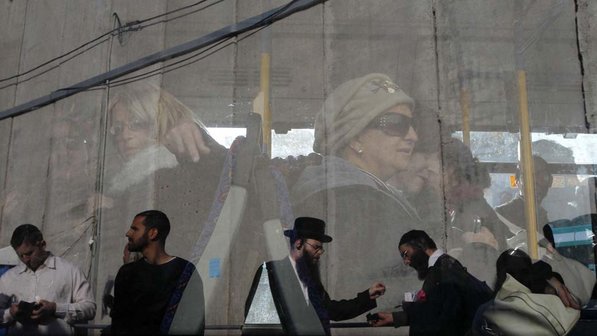 Jewish women sit on a bus outside Rachel’s Tomb in the West Bank town of Bethlehem as men standing next to the controversial Israeli barrier are reflected in the bus window on Nov. 8. Photo by Reuters/Baz Ratner
Jewish women sit on a bus outside Rachel’s Tomb in the West Bank town of Bethlehem as men standing next to the controversial Israeli barrier are reflected in the bus window on Nov. 8. Photo by Reuters/Baz Ratner
For many Israeli leaders, the fight then, is not primarily about women’s rights. It’s about holding together a fragile pluralistic democracy.
At least we in the United States can be proud of ourselves for working through the thorny issue of integration decades ago . . . or can we? TLJNews recently published this image of a segregated bus:
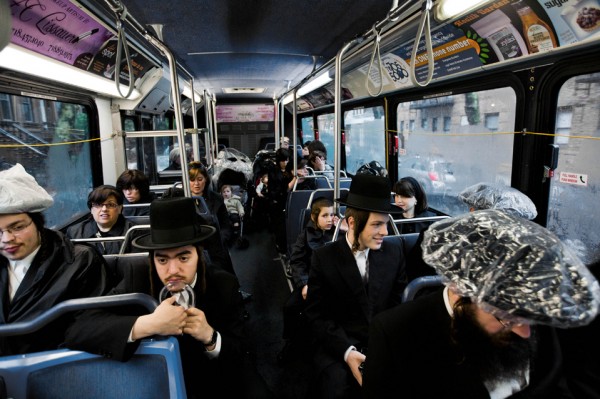 Hasidic Jewish men sit in front and women sit in back on the B110 bus between Borough Park and Williamsburg in Brooklyn on Oct. 27, 2011. (Philip Montgomery for The Wall Street Journal)
Hasidic Jewish men sit in front and women sit in back on the B110 bus between Borough Park and Williamsburg in Brooklyn on Oct. 27, 2011. (Philip Montgomery for The Wall Street Journal)
It was taken on the B110 Williamsburg-to-Borough Park bus line . . . in Brooklyn, New York. When a female reporter boarded the bus she was reportedly approached by a “gentleman, who appeared to be an ultra-Orthodox Hasidic Jew” and told her: “Ladies in the back.” Of course, in the USA, that custom is enforced by community practice, not law, and the bus company insists that it does not “support, promote or condone any conduct that is discriminatory in nature.” And yet, there the ladies sit. In the back.
— By Karrin Anderson


Reactions
Comments Powered by Disqus